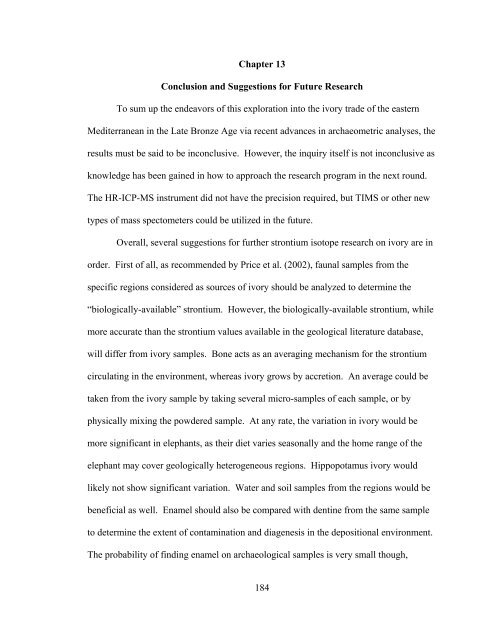Tracing the Source of the Elephant And Hippopotamus Ivory from ...
Tracing the Source of the Elephant And Hippopotamus Ivory from ...
Tracing the Source of the Elephant And Hippopotamus Ivory from ...
Create successful ePaper yourself
Turn your PDF publications into a flip-book with our unique Google optimized e-Paper software.
Chapter 13<br />
Conclusion and Suggestions for Future Research<br />
To sum up <strong>the</strong> endeavors <strong>of</strong> this exploration into <strong>the</strong> ivory trade <strong>of</strong> <strong>the</strong> eastern<br />
Mediterranean in <strong>the</strong> Late Bronze Age via recent advances in archaeometric analyses, <strong>the</strong><br />
results must be said to be inconclusive. However, <strong>the</strong> inquiry itself is not inconclusive as<br />
knowledge has been gained in how to approach <strong>the</strong> research program in <strong>the</strong> next round.<br />
The HR-ICP-MS instrument did not have <strong>the</strong> precision required, but TIMS or o<strong>the</strong>r new<br />
types <strong>of</strong> mass spectometers could be utilized in <strong>the</strong> future.<br />
Overall, several suggestions for fur<strong>the</strong>r strontium isotope research on ivory are in<br />
order. First <strong>of</strong> all, as recommended by Price et al. (2002), faunal samples <strong>from</strong> <strong>the</strong><br />
specific regions considered as sources <strong>of</strong> ivory should be analyzed to determine <strong>the</strong><br />
“biologically-available” strontium. However, <strong>the</strong> biologically-available strontium, while<br />
more accurate than <strong>the</strong> strontium values available in <strong>the</strong> geological literature database,<br />
will differ <strong>from</strong> ivory samples. Bone acts as an averaging mechanism for <strong>the</strong> strontium<br />
circulating in <strong>the</strong> environment, whereas ivory grows by accretion. An average could be<br />
taken <strong>from</strong> <strong>the</strong> ivory sample by taking several micro-samples <strong>of</strong> each sample, or by<br />
physically mixing <strong>the</strong> powdered sample. At any rate, <strong>the</strong> variation in ivory would be<br />
more significant in elephants, as <strong>the</strong>ir diet varies seasonally and <strong>the</strong> home range <strong>of</strong> <strong>the</strong><br />
elephant may cover geologically heterogeneous regions. <strong>Hippopotamus</strong> ivory would<br />
likely not show significant variation. Water and soil samples <strong>from</strong> <strong>the</strong> regions would be<br />
beneficial as well. Enamel should also be compared with dentine <strong>from</strong> <strong>the</strong> same sample<br />
to determine <strong>the</strong> extent <strong>of</strong> contamination and diagenesis in <strong>the</strong> depositional environment.<br />
The probability <strong>of</strong> finding enamel on archaeological samples is very small though,<br />
184

















